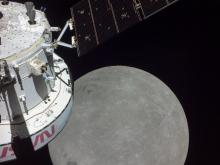Listen to today's episode of StarDate on the web the same day it airs in high-quality streaming audio without any extra ads or announcements. Choose a $8 one-month pass, or listen every day for a year for just $30.
You are here
Moon and Venus
Venus has been largely ignored over the last decade or two. Only one spacecraft is operating at the planet now — a Japanese orbiter. Several craft have taken a peek as they’ve flown past Venus while they were using its gravity to sling them elsewhere in the solar system. But most of the planetary attention has been focused on Mars.
That neglect is scheduled to end soon, because the United States and Europe have approved new missions to the planet.
The U.S. will send two missions — the first since the 1990s.
DAVINCI+ will drop instruments into Venus’s hot, dense atmosphere. They’ll examine the atmosphere and snap pictures of the surface below. The mission also includes an orbiter, which will image the planet at wavelengths that are invisible to the eye.
VERITAS is also an orbiter. It will map the surface by using radar to peer through the clouds that blanket Venus. It’ll also look for active volcanoes. Previous missions have found hints that some volcanoes are active, but no confirmation.
The European mission is called EnVision. It, too, will map the surface and look for volcanoes. It’ll also probe the layers below the surface — helping scientists figure out just how active our neighbor world really is.
Look for Venus low in the southwest after sunset. It’s the brilliant “evening star,” so you can’t miss it. Tonight, it’s close below the crescent Moon, with the bright star Antares off to their left.
Script by Damond Benningfield





